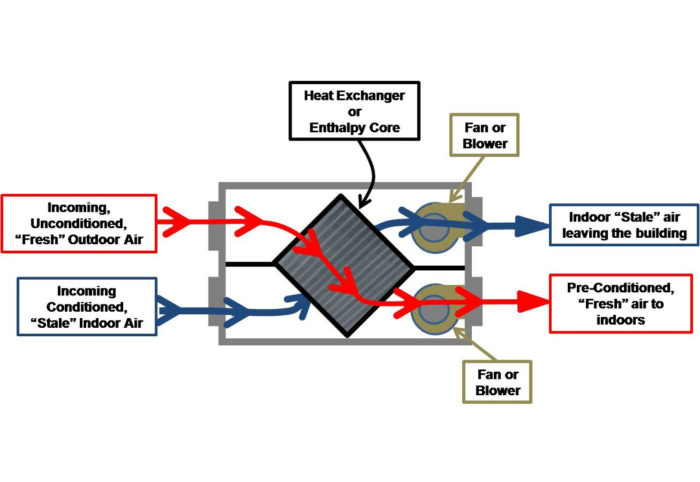The Future of HRV in Energy-Efficient Home Design
Checking out the Benefits of Heat Recovery Ventilation for Power Efficiency in Houses
Heat Recovery Ventilation (HRV) systems offer home owners a functional method to enhancing energy performance. By redeeming warm from outgoing air, these systems can considerably reduce cooling and heating expenses. Additionally, they give a consistent supply of fresh air, enhancing interior air quality and comfort levels. As house owners take into consideration lasting alternatives, recognizing the nuances of HRV systems becomes progressively important. What variables should one examine before making such a financial investment?
Understanding Heat Recovery Ventilation Equipments

Exactly How HRV Boosts Indoor Air High Quality

Power Financial Savings: The Financial Advantages of HRV
Making the most of energy efficiency, heat recovery ventilation (HRV) systems use considerable monetary advantages for home owners. By recovering and reusing warm from exhaust air, HRVs significantly minimize heating & cooling costs. This YOURURL.com modern technology can result in power savings of as much as 30%, relying on climate and use patterns. House owners usually notice minimized utility costs shortly after installation, making HRVs a financially wise financial investment with time. Furthermore, numerous areas give motivations or rebates for energy-efficient upgrades, better enhancing the monetary allure. As energy prices remain to rise, the cost-effectiveness of HRVs becomes significantly clear. Generally, the incorporation of HRV systems not just promotes power effectiveness yet likewise contributes to lasting financial cost savings for homes.
The Ecological Effect of Heat Recovery Ventilation
A substantial environmental benefit of heat recovery ventilation (HRV) systems depends on their ability to lower general power consumption. By reclaiming warmth from exhaust air and transferring it to incoming fresh air, HRV systems reduce the demand for energy-intensive home heating and cooling methods. This decrease in energy need adds to lower greenhouse gas exhausts, as less nonrenewable fuel source is needed to maintain comfy interior temperatures. In addition, HRV systems enhance indoor air quality by effectively trading stagnant air with fresh outdoor air, decreasing reliance on mechanical air conditioning systems that can damage the setting. Overall, the application of HRV systems sustains sustainable living methods and lines up with international efforts to fight climate change by advertising energy effectiveness in household setups.
Selecting the Right HRV System for Your Home
Exactly how can house owners ensure they pick the best heat recovery ventilation (HRV) system for their requirements? They need to evaluate their home's dimension and format, as these Click Here factors influence air movement needs. Next off, examining the system's performance scores is essential, as higher rankings indicate much better performance and power savings. House owners should additionally take into consideration setup and upkeep expenses, comparing various brand names and versions for value. Click This Link Additionally, it is essential to review noise levels, as some systems operate even more quietly than others. Consulting with HVAC experts can supply customized suggestions based on certain home conditions. Lastly, checking out individual reviews and warranties can help in making a notified choice, guaranteeing that the selected HRV system efficiently improves interior air quality and power performance.
Frequently Asked Inquiries

Exactly how Typically Should I Clean or Maintain My HRV System?
The frequency of cleaning or maintaining a warmth recuperation ventilation (HRV) system commonly depends on usage and ecological factors. Usually, it is recommended to perform upkeep every six months to guarantee peak performance and air quality.

Can HRV Equipments Help In Reducing Humidity Degrees Inside Your Home?
HRV systems can effectively reduce interior moisture degrees by trading stagnant, moist air with fresh, drier air from outdoors. HRV Heat Recovery Ventilation. This procedure helps keep a well balanced indoor atmosphere, boosting comfort and stopping moisture-related problems
What Is the Life-span of a Typical HRV System?
The lifespan of a regular heat recovery ventilation (HRV) system differs, typically lasting between 10 to 15 years. Routine maintenance can expand its efficiency and operational life, making sure peak efficiency throughout its usage duration.
Exist Any Kind Of Sound Worry About HRV Solutions?
Noise interest in HRV systems can occur, especially from follower procedure. Many contemporary units are developed to minimize sound degrees, guaranteeing they run quietly while preserving performance, which attends to prospective disturbances in living settings.
Can I Install an HRV System Myself, or Do I Required an Expert?
The private contemplated whether to set up the heat recovery ventilation (HRV) system personally or employ a specialist. Typically, while do it yourself installment is possible, proficiency assurances proper performance and compliance with neighborhood building regulations, enhancing system performance.